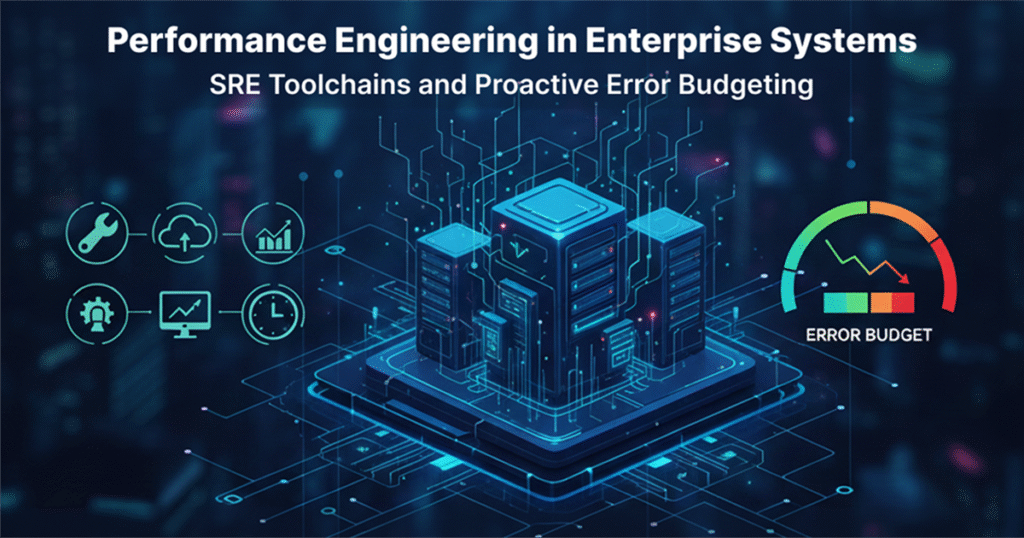In the landscape of modern Enterprise Systems, the definition of performance has fundamentally changed. It’s no longer just about milliseconds; it’s about resilience, efficiency, and continuous availability. For businesses operating at scale, system outages or degraded service are not merely technical failures—they are existential threats. To manage this complexity, organizations have rapidly adopted Site Reliability Engineering (SRE), creating a pragmatic, engineering-focused approach to operations. The intersection of modern SRE Toolchains and rigorous Proactive Error Budgeting is the critical formula for mastering continuous Performance Engineering today.

The Performance Shift: From Reactive Testing to Reliability Engineering
For decades, performance testing was a late-stage gate: a frantic, last-minute sprint to load-test before release. This reactive approach is unsustainable for modern, distributed architectures (microservices, multi-cloud). The current mandate, driven by Reliability Engineering principles, is to “shift left.”
This means embedding performance thinking and testing into every phase of the Software Development Life Cycle (SDLC). When SREs get involved in architecture, security, and development practices early on, they prevent the very performance problems that once plagued late-stage QA. This cultural and procedural shift is powered by automation, and the tools we use are the engine.
The Engine of Reliability: Why SRE Toolchains are Enterprise-Critical
The modern SRE toolchain is far more than a collection of monitoring dashboards; it’s a unified system designed to eliminate toil and provide high-fidelity feedback. For Enterprise Systems, these tools must be integrated, scalable, and self-service.
1. Observability (The Eyes and Ears): We’ve moved beyond simple monitoring. True observability requires three pillars: metrics (what’s happening now?), logs (what happened?), and distributed tracing (how did a single request move across 50 services?). Tools like Prometheus, Grafana, Datadog, and those adhering to the OpenTelemetry standard are non-negotiable for understanding complex dependencies and achieving effective Performance Engineering.
2. Automation & Platform Engineering (The Hands): The Google SRE mandate states that engineers should spend at least 50% of their time on engineering projects, not operational toil. This is only possible through heavy automation. Infrastructure as Code (IaC) tools like Terraform ensure environments are provisioned consistently and reliably. Furthermore, the strategic adoption of Platform Engineering is transforming the toolchain itself into an internal product. This platform provides developers with self-service reliability capabilities by default, scaling the SRE mindset without requiring an SRE in every squad.
The Governance Layer: Proactive Error Budgeting
The key to balancing development velocity (shipping features fast) with reliability (keeping the system up) is Proactive Error Budgeting. This governance model is simple yet profoundly impactful:
1. Defining the Line (SLOs): We start with Service Level Objectives (SLOs), which define the explicit target for service quality (e.g., “99.9% of user requests must return in less than 300ms”). This is the language that ties technical performance to business impact.
2. The Budget: The Error Budget is the allowable time the service can be below its SLO. For a 99.9% SLO over 30 days, the budget is about 43 minutes of acceptable downtime or performance degradation.
3. The Proactive Mechanism: This is where the budget gets its power. If the budget is healthy, the development team can maintain high feature velocity. If the budget is being rapidly depleted (due to incidents or regressions), development work is halted, and the entire team shifts focus to paying down the reliability debt. This Proactive Error Budgeting forces the organization to treat reliability as a necessary prerequisite for shipping new code. It ensures that performance issues trigger an immediate, mandatory engineering response, preventing minor issues from becoming catastrophic failures across entire Enterprise Systems.
The biggest challenge here is not the math, but the culture—establishing consistent SLO definitions and ensuring that product owners and development leads truly own the budget alongside Reliability Engineering teams.
The Next Frontier: AIOps and Controlled Chaos
To push Performance Engineering further, modern SRE practices are embracing advanced techniques:
1. AIOps for Predictive Reliability: Leveraging AI/ML on large volumes of observability data to move from reactive alerting to predictive autoscaling and proactive anomaly detection. This helps SREs remediate issues before they even trigger an outage.
2. Chaos Engineering: Instead of waiting for failure, teams inject controlled, deliberate failures into the system (e.g., Gremlin, Chaos Monkey). This practice verifies that the system’s automated recovery mechanisms—managed by the SRE toolchain—actually work as expected under production load. This controlled chaos is the ultimate stress test for Enterprise Systems resilience.
Mastering Performance Engineering in today’s complex environment demands a data-driven culture. By implementing sophisticated SRE Toolchains to eliminate toil and enforce reliability through Proactive Error Budgeting, organizations can confidently deliver the stability and speed that modern Enterprise Systems demand.
Search
Categories

Author
-
Priyashalini is a Quality Control with 8 years of experience Manual and Automation Testing .She leads the QC team, coordinates inspection activities and maintains compliance with client, company, and industry specifications, Strategy and Planning. Also Problem Solving & Continuous Improvement, Documentation & Reporting .Identify skill gaps and arrange training for team members on new tools, methodologies, or project-specific technologies.Review and approve test cases and test scripts created by the team to ensure comprehensive coverage and accuracy against requirements.
